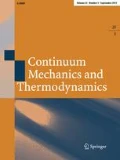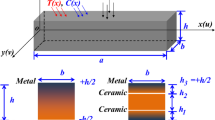Abstract
This paper investigates the failure strain as a dependence of the stress triaxiality and the Lode angle parameter for polyurethane rigid foams (PUR) of two densities (100 and \(300\,\hbox {kg/m}^{3})\). Tests were carried out in tension for various configurations, resulting in different states of stress triaxiality at various Lode angles in the critical areas. The failure strain was determined for each setup using finite element analysis, as the tests were replicated with numerical models. The displacement at failure recorded in the experiments was imposed for the models, determining the failure strain as a function of stress triaxiality and the Lode angle parameter. The results were validated through the analysis of the failure of sandwich structures with aluminium faces and PUR cores.


















Similar content being viewed by others
Abbreviations
- d :
-
Plastic displacement
- D :
-
Damage evolution parameter
- \(e^{\mathrm{c}}\) :
-
Logarithmic compressive strain
- \(e^{\mathrm{t}}\) :
-
Logarithmic tensile strain
- \(I_{1}\) :
-
First invariant of the stress tensor
- \(J_{2}\) :
-
Second invariant of the deviatoric stress tensor
- \(J_{3}\) :
-
Third invariant of the deviatoric stress tensor
- p :
-
Hydrostatic pressure
- \(p^{\mathrm{c}}\) :
-
Yield stress in hydrostatic compression
- \(p^{\mathrm{t}}\) :
-
Yield stress in hydrostatic tension
- q :
-
von Mises equivalent stress
- r :
-
Normalized third invariant
- \(s^{\mathrm{c}}\) :
-
True compressive stress
- \(s^{\mathrm{t}}\) :
-
True tensile stress
- \(\gamma \) :
-
Bai–Wierzbicki Lode angle-dependent parameter
- \(\varepsilon ^{\mathrm{c}}\) :
-
Engineering compressive strain
- \(\varepsilon ^{\mathrm{t}}\) :
-
Engineering tensile strain
- \(\bar{\varepsilon }_{\mathrm{D}}^{\mathrm{pl}}\) :
-
Critical plastic strain
- \(\bar{\varepsilon }^{\mathrm{pl}}\) :
-
Equivalent plastic strain
- \(\dot{\bar{\varepsilon }}^{\mathrm{pl}}\) :
-
Equivalent plastic strain rate
- \(\eta \) :
-
Stress triaxiality
- \(\bar{\theta }\) :
-
Lode angle
- \(\nu \) :
-
Poisson’s ratio
- \(\xi \) :
-
Lode angle parameter
- \({{\varvec{\sigma }}}\) :
-
Stress tensor
- \(\bar{{\varvec{\sigma }}}\) :
-
Effective stress tensor
- \(\sigma ^{\mathrm{c}}\) :
-
Engineering compressive stress
- \(\sigma ^{\mathrm{t}}\) :
-
Engineering tensile stress
- \(\sigma _{ij}\) :
-
Stress tensor components
- \(\sigma _{i}\) :
-
Principal stresses
- \({{\varvec{\sigma }}}^{\prime }\) :
-
Deviatoric stress tensor
- \(\sigma _{ij}^{\prime }\) :
-
Deviatoric stress tensor components
- \(\sigma _{\mathrm{y}}\) :
-
Equivalent yield stress
- \(\Phi \) :
-
Yield function
- \(\psi \) :
-
Dissipated plastic energy
- \(\omega \) :
-
Damage initiation parameter
References
Gibson, L., Ashby, M.: Cellular Solids: Structure and Properties. Cambridge University Press, Cambridge (1997)
Şerban, D., Linul, E., Voiconi, T., Marsavina, L., Modler, N.: Numerical evaluation of two-dimensional micromechanical structures of anisotropic cellular materials: case study for polyurethane rigid foams. Iran. Polym. J. 24, 515–529 (2015)
Şerban, D., Voiconi, T., Linul, E., Marşavina, L., Modler, N.: Viscoelastic properties of PUR foams: impact excitation and dynamic mechanical analysis. Materiale Plastice 52, 537–541 (2015)
Marşavina, L., Şerban, D., Pop, C., Negru, R.: Experimental investigation of failure modes for sandwich beams. In: 16th International Conference on Fracture and Damage Mechanics. Key Engineering Materials, vol. 754, pp. 115–118 (2017)
Negru, R., Marşavina, L., Filipescu, H.: Evaluation of generalized MTS criterion for mixed-mode fracture of polyurethane materials. In: Advances in Fracture and Damage Mechanics XII, Key Engineering Materials, vol. 557–558, pp. 117–120 (2014)
Negru, R., Marşavina, L., Voiconi, T., Linul, E., Filipescu, H., Belgiu, G.: Application of TCD for brittle fracture of notched PUR materials. Theor. Appl. Fract. Mech. 80, 87–95 (2015)
Marşavina, L., Berto, F., Negru, R., şerban, D., Linul, E.: An engineering approach to predict mixed mode fracture of PUR foams based on ASED and micromechanical modelling. Theor. Appl. Fract. Mech. 91, 148–154 (2017)
Zapara, M.A., Tutyshkin, N.D., Müller, W.H., Weinberg, K., Wille, R.: A physico-mechanical approach to modeling of metal forming processes—part I: theoretical framework. Contin. Mech. Thermodyn. 20, 231–254 (2008)
Hosford, W.: A generalized isotropic yield criterion. J. Appl. Mech. 39(2), 607–609 (1972)
Bai, Y., Wierzbicki, T.: A new model of metal plasticity and fracture with pressure and Lode dependence. Int. J. Plast. 24, 1071–1096 (2008)
Deshpande, V., Fleck, N.: Multi-axial yield behaviour of polymer foams. Acta Materialia 49, 1859–1866 (2001)
Tutyshkin, N.D., Lofink, P., Müller, W.H., Wille, R., Stahn, O.: Constitutive equations of a tensorial model for strain-induced damage of metals based on three invariants. Contin. Mech. Thermodyn. 29, 251–269 (2017)
Abaqus, “User’s Manual,” vol. Analysis (2017)
Şerban, D., Marşavina, L., Modler, N.: Finite element modelling of the progressive damage and failure of thermoplastic polymers in puncture impact. In: Proceedings of the XXIII Italian Group of Fracture Meeting, Procedia Engineering, vol. 109, pp. 97–104 (2015)
ISO 527, Plastics—Determination of Tensile Properties, International Standard Organization (1996)
Bleistein, T., Jung, A., Diebels, S.: A microsphere-based material model for open cell metal foams. Contin. Mech. Thermodyn. 32, 255–267 (2020)
Şerban, D., Weber, G., Marşavina, L., Silberschmidt, V., Hufenbach, W.: Tensile properties of semi-crystalline thermoplastic polymers: effects of temperature and strain rates. Polym. Test. 32, 413–425 (2013)
Şerban, D., Marşavina, L., Rusu, L., Negru, R.: Numerical study of the behavior of magnesium alloy AM50 in tensile and torsional loadings. Arch. Appl. Mech. 89(5), 911–917 (2019)
ISO 6892-1, Metallic materials—tensile testing—part 1: method of test at room temperature. International Standard Organization (2019)
Murugesan, M., Jung, D.W.: Johnson Cook material and failure model parameters estimation of AISI-1045 medium carbon steel for metal forming applications. Materials 12, 609 (2009)
Bao, Y., Wierzbicki, T.: On the cut-off value of negative triaxiality for fracture. Eng. Fract. Mech. 72, 1049–1069 (2005)
Pineau, A., Benzerga, A., Pardeon, T.: Failure of metals I: Brittle and ductile fracture. Acta Materialia 107, 424–483 (2016)
Bridgman, P.: Studies in Large Plastic Flow and Fracture—with Special Emphasis on the Effects of Hydrostatic Pressure. McGraw-Hill, New York (1952)
Acknowledgements
This work was supported by the Romanian National Authority for Scientific Research and Innovation, CCCDI—UEFISCDI, projects number PD 13/2018 and CCCDI—UEFISCDI, project number PN-III-P1-1.2-PCCDI-2017-0391/CIA_CLIM.
Author information
Authors and Affiliations
Corresponding author
Additional information
Communicated by Luca Placidi and Emilio Barchiesi.
Publisher's Note
Springer Nature remains neutral with regard to jurisdictional claims in published maps and institutional affiliations.
Rights and permissions
About this article
Cite this article
Şerban, DA., Negru, R., Filipescu, H. et al. Investigations on the influence of the triaxial state of stress on the failure of polyurethane rigid foams. Continuum Mech. Thermodyn. 35, 905–918 (2023). https://doi.org/10.1007/s00161-020-00924-x
Received:
Accepted:
Published:
Issue Date:
DOI: https://doi.org/10.1007/s00161-020-00924-x




